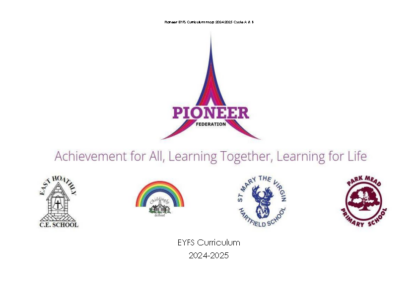Organisation
Our exciting, broad and balanced curriculum is taught across our Nursery and Reception Classes. Each term has a focussed topic theme, and key questions for children to consider.
Key Documents
We use key documents to support the ongoing and reflective development of our curriculum, assessment and planning cycles within the EYFS.
- EYFS Framework (September 2021, Statutory Guidance) – This is used to consider pedagogy within our environments and ensure we are following guidelines. In addition to this, through looking at the educational programmes, we have shaped statements within our Intent and Implementation sections in the curriculum map, to highlight the key experiences and learning children will be having and the knowledge the children will gain.
- The Early Learning Goals, are used to assess pupils at the end of the academic year. Aspects of these goals can be seen within our impact statements and curriculum maps to show how we are developing children’s skills in these areas. They have not been used to plan the curriculum, but should be skills the children have developed during their experiences.
- Development Matters and Birth to 5 (2021, Non Statutory Guidance) – These documents are used as a tool to draw upon when considering pupils strengths and areas of need. They are used within professional assessment and planning discussions. Pioneer teaching staff will have copies of these documents with their assessment files to draw upon. These are not used as checklists, but they can be used to support progression in planning and provision.
Content and Sequence
The EYFS team across the Federation have reviewed the new framework and supporting documents to plan opportunities that deepen children’s understanding, knowledge, skills and language through linking with their local area and community, and enjoying key texts and topic-themed experiences.
Examples of this include:
- Children at St Mary’s will be participating in Maypole dancing, as part of their community events.
- Children at East Hoathly will be exploring the significance of remembrance celebrations in the village.
- Children at Chiddingly will be developing their understanding of artists that have visited the local area.
- Children at Park Mead will be making links with their local schools, to expand their physical development opportunities.
The curriculum is sequenced in this order to allow pupils to learn and then embed the core foundations they will need to then build upon in each topic and term. For example, the sequence of systematic approach of teaching phonics and number development in Term 1 and 2 will then enable children to access wider activities and provision in subsequent terms, i.e. recognising amounts will support understanding of addition, and grouping or knowing individual phonic sounds will enable children to start early writing through labelling and letter formation.
Vocabulary, language and communication are key areas that thread throughout our curriculum and experiences giving pupils a variety of opportunities to expand and develop their language skills. In addition pupil’s holistic wellbeing will be supported throughout their early years journey, which will include topics such as oral health, mindfulness and self-regulation.
Our specific areas of learning, (Literacy, Maths, Understanding the World and Expressive Art & Design) have all been planned to support children’s learning in line with their open-ended interests and individual schools’ local areas. Some of the others factors also include:
- Weather – Some topics are more suited to certain weather conditions and seasons, such as exploring autumnal changes in Term 2, and what happens in spring in Terms 3 & 4.
- Time of the year & local events – Some topics are in terms where anniversaries or celebrations occur, such as Remembrance and Bonfire Night in November to link with the anniversary of the date the events happened.
- Sequence in learning – As the children begin to understand different concepts, they can begin to apply these in a range of situations. They also begin to see patterns and connect their previous learning, for example focusing on Phase 1 phonics in Nursery and then utilising these listening skills in Phase 2, 3, 4 phonics all across the Reception year.
Impact and Knowledge-gained
The skills and knowledge from the different areas of learning are carefully aligned to ensure a correlated cross-curricular approach to the children’s learning, whilst providing flexibility to adapt and follow the individual cohort interests. The curriculum has been designed to allow children regular opportunities to revisit and embed core-learning skills, such as developing vocabulary & language through playing; exploring, reading, writing and mastering early maths concepts. The timetable of the days (weeks, terms and year) is a careful balance of child initiated learning, play and exploration and regular guided teaching moments.
In Early Years the learning is tailored to individual needs and will be made accessible to children through strategies that work for them, this may include sensory activities, calm or quiet zones, through images or signs, brining learning through a specific interest. Children across our early years environments are supported to feel they can express themselves and staff work closely with the SENCO to develop individualised tasks and curriculums for children that are appropriate.
Additional Downloads
The curriculum for the Nursery and Reception classes consists of two cycles, with the core intent remaining the same across both. For example, in Term 3, Cycle 1, the topic is entitled ‘Off We Go’ and we focus on transport, as well as on the big question ‘who helps us.’ To support this, we draw on a range of texts, learning experiences and visits. In Term 3, Cycle 2, the topic is entitled ‘Blast Off’ and the prior learning is built on, revisiting some texts and experiences but drawing from many others, with the big question also remaining the same but the range of experiences and texts also being varied and extended.
This is to ensure that the children who begin their education with us in our preschool settings are able to deepen and broaden their knowledge, understanding and experiences over their two year EYFS journey.


